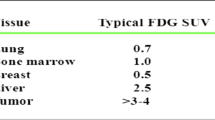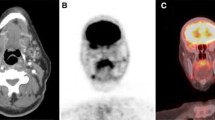Abstract
Whole-body fluorine-18 fluorodeoxyglucose (FDG) positron emission tomography (PET) imaging was performed during the follow-up of 33 patients suffering from differentiated thyroid cancer. Among them there were 26 patients with papillary and seven with follicular tumours. Primary tumour stage (pT) was pT1 in six cases, pT2 in eight cases, pT3 in three cases and pT4 in 14 cases. FDG PET was normal in 18 patients. In three patients a slightly increased metabolism was observed in the thyroid bed, assumed to be related to remnant tissue. In one case local recurrence, in ten cases lymph node metastases (one false-positive, caused by sarcoidosis) and in three cases distant metastases were found with FDG PET. In comparison with whole-body scintigraphy using iodine-131 (WBS) there were a lot of discrepancies in imaging results. Whereas three patients had distant metastases (proven with131I) and a negative FDG PET, in four cases131I-negative lymph node metastases were detectable with PET. Even in the patients with concordant ‘staging”, differences between131I and FDG were observed as to the exact lesion localization. Therefore, a coexistence of131I-positive/FDG-negative,131I-negative/FDG-positive and131I-positive/FDG-positive malignant tissue can be assumed in these patients. A higher correlation of FDG PET was observed with hexakis (2-methoxyisobutylisonitrile) technetium-99m (I) (MIBI) scintigraphy (performed in 20 cases) than with WBS. In highly differentiated tumours131I scintigraphy had a high sensitivity, whereas in poorly differentiated carcinomas FDG PET was superior. The clinical use of FDG PET can be recommended in all cases of suspected or proven recurrence and/or metastases of differentiated thyroid cancer and is particularly useful in cases with elevated serum thyroglobulin levels and negative WBS.
Similar content being viewed by others
References
Goolden AWG. The indication for ablating normal thyroid tissue with131I in differentiated thyroid cancer.Clin Endocrinol 1985; 23: 81–86.
Dadparvar S, Krishna L, Brady LW et al. The role of131iodine-Na and201thallium imaging and serum thyroglobulin in the management of differentiated carcinoma.Cancer 1993; 71: 3767–3773.
Balone HR, Fing-Bennett D, Stoffer SS.99mTechnetium-sestamibi uptake by recurrent Hürthle cell carcinoma of the thyroid.J Nucl Med 1992; 33: 1393–1395
Klemm E, Hotze AL, Briele B, Biersack HJ.99mTc-MIBI and201thallium scintigraphy in the follow-up of differentiated thyroid carcinoma. In: Hollinger MA, ed.Handbook of targeted delivery of imaging agents. Boca Raton, Fl.: CRC Press; 1995: 249–256.
Briele B, Hotze AL, Kropp J, et al. A comparison of 201Ti and99mTc-MIBI in the follow-up of differentiated thyroid carcinoma.Nucl Med 1991; 30: 115–124.
Strauss LG, Conti PS. The application of PET in clinical oncology.J Nucl Med 1991; 32: 623–648.
Hawkins RA, Hoh C, Dahlbom M, et al. PET cancer evaluation with FDG [editorial].J Nucl Med 1991; 32: 1555–1557.
Joensuu H, Ahonen A. Imaging of metastases of thyroid carcinoma with fluorine-18 fluorodeoxyglucose.J Nucl Med 1987; 28: 910–914.
Sisson JC, Ackermann RJ, Meyer MA. Uptake of 18-fluoro-2deoxy-d-glucose by thyroid cancer: implications for diagnosis and therapy.J Clin Endocrinol Metab 1993; 77: 1090–1094.
Fridrich L, Messa C, Landoni C, et al. PET/[F-18]FDG and I-131 scintigraphy in patients with thyroid carcinoma (ThC).Eur J Nucl Med 1994; 2: 780.
Baqai FH, Conti PS, Singer PA, et al.18F-FDG-PET scanning — a diagnostic tool for detection of recurrent and metastatic differentiated thyroid cancers [abstract]. 68th annual meeting of the American Thyroid Association, Chicago 1994, p 9.
Platz D, Lübeck M, Beyer W, et al. Einsatz der [18F]-deoxy-glucose-PET (FDG-PET) in der Nachsorge von Patienten mit differenziertem und medullärem Schilddrüsencarcinom.Nucl Med 1995; 34: 152.
Easton E, Coates D, McKusick A, et al. Concurrent FDG F-18 thyorid PET imaging in 1-131 therapy patients.J Nucl Med 1995;36:197.
Feine U, Lietzenmayer R, Hanke JP, Wöhrle H, Müller-Schauenburg W.18FDG whole-body PET in differentiated thyroid carcinoma.Nucl Med 1995; 34: 127–134.
Spiessl B, Beahrs OH, Hermanek P, et al. TNM-Atlas.Illustrierter Leitfaden zur TNM/pTNM-Klassifikation maligner Tumoren/International Union Against Cancer/Union Internationale Contre le Cancer (UICC). Berlin Heidelberg New York: Springer; 1993: 58.
Biersack HJ, Helpap B, Koch U, et al. Should treatment of highly differentiated thyroid carcinoma be conservative?Nucl Med 1983; 22: 20–23.
Grünwald F, Ruhlmann J, Ammari B, et al. Experience with a high-dose concept of differentiated metastatic thyroid cancer therapy. Nucl Med 1988; 27: 266–271.
Biersack HJ, Hotze A. The clinician and the thyroid. Eur J Nucl Med 1991; 18: 761–778.
Hotze AL, Briele B, Grünwald F, et al. Determination of serum human thyroglobulin (hTg) with a new IRMA system in patients with differentiated thyroid carcinoma.Radiol Diagn 1991; 32: 383–386.
Black EG, Sheppard MC. Serum thyroglobulin measurement in thyroid cancer: evaluation of “false” positive results.Clin Endocrinol 1991; 35: 519–520.
Ozata M, Suzuki S, Miyamoto T, Liu RT, Fierro-Renoy F, Degroot LJ. Serum thyroglobulin in the follow-up of patients with treated differentiated thyroid cancer.J Clin Endocrinol Metab 1994; 79: 98–105.
Lubin E, Mechlis-Frish S, Zatz S, et al. Serum thyroglobulin and iodine-131 whole-body scan in the diagnosis and assessment of treatment for metastatic differentiated thyroid carcinoma.J Nucl Med 1994; 35: 257–262.
Lewis PJ, Salama A. Uptake of fluorine-l8-fluorodeoxyglucose in sarcoidosis.J Nucl Med 1994; 35: 1647–1649.
Oyen WJG, Mudde AH, van den Brock WJM, Corstens FHM. Metastatic follicular carcinoma of the thyroid: reappearance of radioiodine uptake.J Nucl Med 1995; 36: 613–615.
Joensuu H, Ahonen A, Klemi PJ.18F-fluorodeoxyglucose imaging in preoperative diagnosis of thyroid malignancy.Eur J Nucl Med 1988; 13: 502–506.
Adler LP, Bloom AD, Positron emission tomography of thyroid masses.Thyroid 1993; 3: 195–200.
Scott GC, Meier DA, Dickinson CZ. Cervical lymph node metastasis of thyroid papillary carcinoma imaged with fluorine18-FDG, technetium-99m-pertechnetate and iodine-131-sodium iodide.J Nucl Med 1995, 36: 1843–1845.
Author information
Authors and Affiliations
Rights and permissions
About this article
Cite this article
Grünwald, F., Schomburg, A., Bender, H. et al. Fluorine-18 fluorodeoxyglucose positron emission tomography in the follow-up of differentiated thyroid cancer. Eur J Nucl Med 23, 312–319 (1996). https://doi.org/10.1007/BF00837630
Received:
Revised:
Issue Date:
DOI: https://doi.org/10.1007/BF00837630




